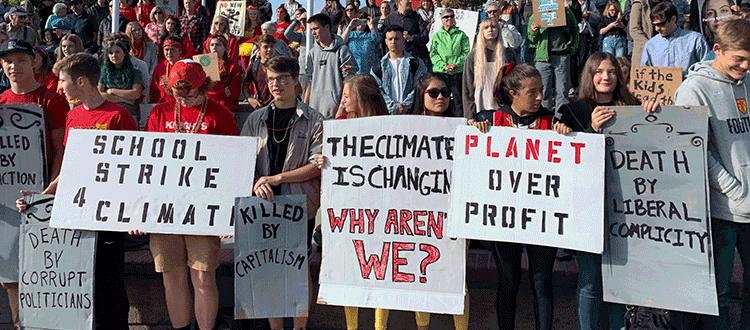How Do Cleaning Products Connect to Climate Change?
 Jamie McConnell Deputy Director |
No matter where you live, you’ve probably felt the impacts of climate change whether that’s increased droughts, flooding, wildfires, snowmelt, etc. (for me in Montana I have definitely felt the impacts of increased wildfires). Climate change is the most significant threat our planet faces and communities of color are especially vulnerable to the impacts.
One of the many contributing factors to climate change is consumption, as the result of the extraction of resources like petroleum and gas used to make products. Take, for example, cleaning products (store aisles are filled with dozens of different cleaners for windows, floors, stoves, toilets, bathtubs, disinfectants — you name it — there is a cleaner for it!)
Cleaning products are made with chemicals and are part of the larger chemical industry. The chemical industry is extremely energy-intensive and is the second (!) largest user of fuel in the manufacturing sector.
Here’s how it works—most of the chemical industry uses petroleum and natural gas to make chemicals. In addition, it takes a ton of energy (heat, pressure, electricity) to create the complex chemical reactions that help turn petroleum and natural gas into different types of chemicals.
And did you know that consumer products (including cleaning products) emit just as much VOC pollution (volatile organic compounds) in to our air as tailpipe emissions from vehicles?
While the cleaning product sector is just one piece of the chemical industry, it still plays role in climate change. Cleaning product companies often talk about their impacts on climate change (and ways they are reducing impacts) in a number of different ways:
- Energy use in the production and distribution of cleaning products (like transporting cleaning products to stores from distribution centers).
- Use of chemicals and plastics (packaging) and the energy it takes to make those chemicals/packaging.
- Energy used by their customers when they use cleaning products (e.g. energy for hot water to wash clothes or dishes)
Companies estimate the third category – customer use – is by far the largest percentage of their overall emissions. For example, Seventh Generation says it is 90% of their emissions, and Reckitt (makers of Lysol) says it makes up 75%.
While this may be true, it unreasonably shifts blame away from corporations and instead places the responsibility on customers, when there are things the companies should be doing more of to reduce their climate impact. Things like making less products (not a popular idea in our capitalistic society), finding more renewable sources to make chemicals, and eliminating the use of plastics, or at least significantly reducing it. Even recycling programs promoted by corporations often put the responsibility on individuals to recycle their plastics, instead of putting energy and resources into packaging options that will reduce new plastic waste from entering our environment in the first place.
But, while we work on changing policies and practices in the cleaning industry, there are additional simple actions we can start doing today when it comes to cleaning products and climate change:
- Buy less—a multi-purpose cleaner can serve many different functions (bathroom cleaner, kitchen cleaner, toilet cleaner, even floor cleaner!)
- Opt for fragrance-free options when available. Fragranced products usually contain more ingredients and are often some of the most toxic ingredients found in cleaners.
- My favorite—make your own cleaning products using kitchen staples like baking soda and vinegar. You cut out the chemical industry all together! You can even store it in glass jars.
- If you have the option, don’t use the heat setting on your dishwasher or washing machine.
While these tips are helpful, it’s really incumbent on the cleaning product industry to implement real solutions and move away from petro-based chemicals, plastic, and marketing dozens of products that perform the same function.




Great post! This is a helpful overview of how we can expect more from our favorite brands, while also shifting our household habits to reduce our personal/family impacts. In regard to encouraging manufacturers to choose renewable sources for chemicals (like surfactants in cleaning products) – does the WVE team have information that shows that “bio-based” chemicals have lower lifecycle carbon emissions? Have we hit that sweet spot yet where we now know it’s better to choose biobased formulas? Thanks for considering! – Brie Welzer, Green Seal
Hi Brie — Good question. And interestingly enough, the Guardian just ran an article that I think you’d be interested in that dives into this a bit: https://www.theguardian.com/environment/2021/nov/22/chemicals-industry-pollution-emissions-climate . In general, I don’t think we have enough data on lifecycles of bio-based products. Inherently they should be better for our planet than oil-based products – but there are lots of factors to consider which could possibly make their manufacture and use as bad or worse than some oil-based products. We (WVE) doesn’t have the data on that. But just making a switch isn’t the full answer without looking at the bigger picture (such as addressing change around how many products/chemicals we really need to produce in the first place; making chemicals in a less energy-intensive way, greater efficiencies in chemical plants, more use of greener power to create chemicals etc…). Thanks for your comment/question Brie!